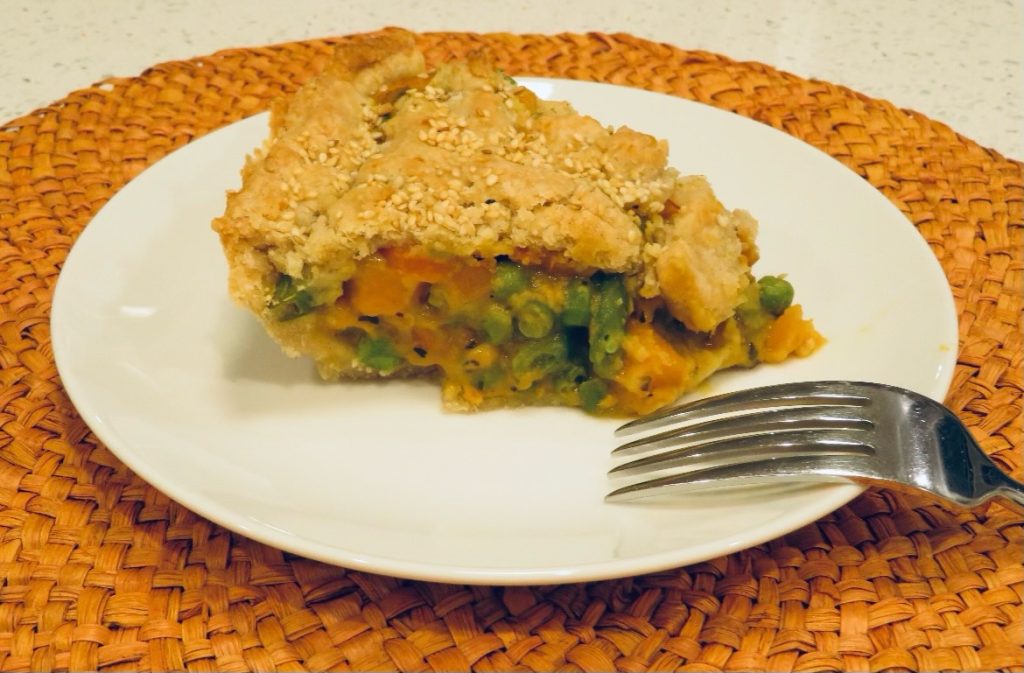VEGAN-GF POT PIE
Updated February 2024
Preparation Time: Up to 3.5 hours (4 if you’re making a gluten-free crust for the first time). Time includes making the piecrust, chilling the crust before rolling it, baking, and cooling time, so start early!
Serves 4 to 6
There’s nothing quite like a pot pie for a one-dish meal that delights all the senses and leaves you feeling completely satisfied. Like many of my recipes, this dish has flexible options to make it your own.
For the double crust/9.5-inch pie plate
8 to 9 tablespoons ice water
1 cup fine almond flour
1 cup King Arthur Gluten-Free Multipurpose Flour
1 cup oat flour
2 tablespoons arrowroot
1 teaspoon mineral salt
½ teaspoon xanthan gum
14 tablespoons coconut oil
¼ cup vegan sour cream or plain yogurt
1 tablespoon chilled apple cider vinegar
2 tablespoons chilled pure maple syrup
For the filling
1 cup fresh peas
1 cup thinly sliced carrots
2 stalk fennel or 1 stalk celery, diced
2 cups cubed sweet potato (1 large potato) cut into ¼-inch cubes
½ cup sliced leek (1 large leek bulb)
1 tablespoon avocado oil
½ teaspoon ground cumin
½ teaspoon ground coriander
½ teaspoon ground turmeric (optional)
1 cup Easy Vegetable Soup Stock
1 sprig marjoram (optional)
2 to 3 sprigs thyme (optional)
1 cup plain almond milk
2 cups green beans, snapped into ½-inch pieces
1 teaspoon arrowroot
1 tablespoon grated fresh ginger
1 tablespoon fresh chopped basil or 1 teaspoon dried
1 tablespoon Bragg Liquid Aminos
1 teaspoon high-mineral salt
1 tablespoon sesame seeds (optional)
Flexible Cook’s Tip: 1. Use any combination of your favorite vegetables equaling 6 cups. If you only have 1 cup of green beans, for example, add more of something else. 2. I like using fresh peas, which take some time to shell so shell them the night before. You can often find bagged fresh peas in stores. When peas are not in season, the pie is also good with a cup of cooked chickpeas (½ cup dry, which should be soaked for 8 hours before cooking). 3. If you don’t have fresh soup stock, use water. 4. If you don’t have almond or another vegan milk, use more soup stock or all water. 5. If you like a less savory filling, cut the ginger to 1 teaspoon and omit the turmeric. Marjoram and thyme also can be omitted or replaced with other herbs, such as parsley.
For the piecrust
Use the directions below to make the dough by hand. Alternatively, make the dough in a food processor.
1. Chill water in freezer at least 15 minutes in advance, if you don’t have refrigerated water or ice available.
2. Whisk together the dry ingredients in a medium-sized mixing bowl. Measure the coconut oil, adding each tablespoon to the flour mixture, and blend the coconut oil into the flour with a pastry cutter until you make small crumbs.
3. Combine 6 teaspoons of ice water in a separate bowl with the yogurt, vinegar, and syrup. Add the liquid gradually to the flour mixture, mixing by hand until the dough comes together. Add another teaspoon of ice water if it seems a bit dry. Divide the dough into two even pieces. Turn each piece of dough onto a sheet of plastic wrap and flatten into a round disk. Wrap each disk in plastic and refrigerate for at least 1 hour. Remove the dough from the refrigerator ½ hour before rolling, giving it a chance to soften slightly.
4. You can roll the pie dough before or after cooking the vegetable filling, or while the vegetables are becoming tender. Roll the bottom crust between sheets of plastic wrap to prevent sticking. (You will need to put two sheets of plastic together for each (tip from America’s Test Kitchen). Remove the top sheet of plastic and invert dough over the pie pan.
5. Roll out the second half of pastry dough as above and set this aside until you have put the filling into the bottom crust and are ready to cover the pie. (See filling directions below.)
For the filling
1. If you’re shelling peas, start the night before to save time.
2. Prepare the carrots, fennel (or celery), green beans, sweet potato, and leek for cooking. Heat oil on medium-low heat in a 3-quart or larger soup pot. Add the leeks and sauté until they turn golden, about 3 minutes. Add the ground spices and stir.
3. Add the carrots and fennel along with 1 cup soup stock, and bring to a gentle boil on medium heat, and cover for about 10 minutes. Then add the cubed sweet potato, bay leaf, marjoram, and thyme leaves along with almond milk (or a second cup of stock or water). Cover and cook for another 5 minutes.
4. Add the snapped green beans to the pot along with the almond milk or more stock (or water), bay leaf, marjoram, and the leaves of the thyme sprigs. Cover and cook for another few minutes.
5. Preheat the oven to 400°F.
6. While the vegetables finish cooking, place the arrowroot powder in a small dish with 2 to 3 tablespoons of hot liquid from the pot. Whisk this mixture until there are no lumps; then stir the arrowroot mixture into the pot. Add the peas and cook another 3 to 5 minutes until the green beans and peas along with all the vegetables are tender. Remove the bay leaf and the sprig of marjoram. Add the grated ginger, basil, Bragg’s, and salt, to taste.
7. If you haven’t already rolled the piecrust, take the pot off the heat and set it aside while you roll out the two crusts and put the bottom crust into the pie pan. (See directions above.) Then pour the vegetable filling into the bottom crust and put set top crust into place, trimming off any excess crust around the edges. You can scallop the edges by pinching the dough between the side of your forefinger and your thumb. Pierce the top crust with a fork a few times. You can even create the image of a large heart at the pie’s center! Sprinkle the top with sesame seeds, if you wish.
8. Bake the pot pie for 30 to 35 minutes or until the crust slightly browned. Let the pie cool for at least 10 minutes to set before cutting to serve.
Vata types may want to add ¼ teaspoon black pepper to support digestion of the peas.
If you're watching your weight, make a no-crust dish and enjoy the filling as a vegetable stew!





